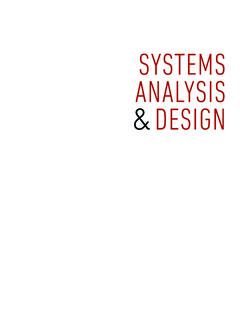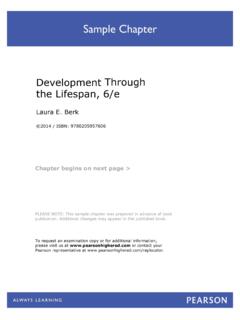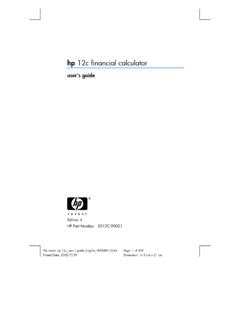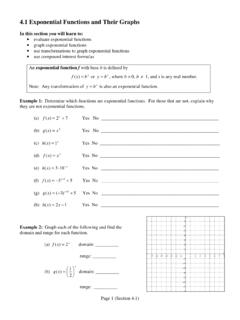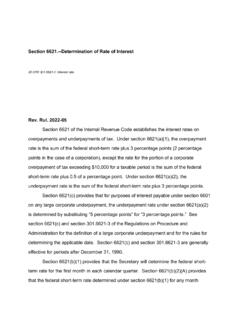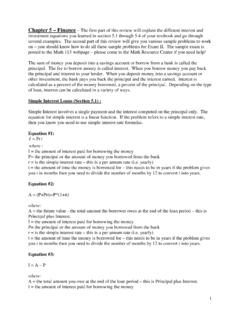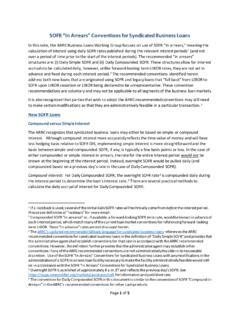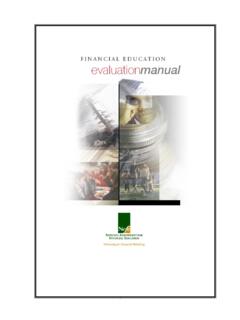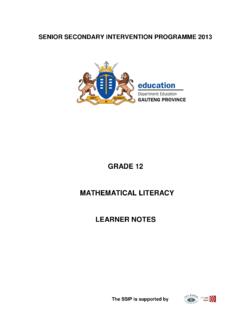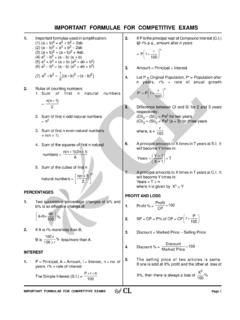Transcription of The Mathematics of Finance - Pearson
1 430 This chapter presents several topics in the Mathematics of Finance , including com-pound and simple interest , annuities, and amortization. Computations are carried out in the traditional way, with formulas, and with Amortization of Personal Financial A Unifying EquationThe Mathematics of Finance10chapterCompound and Simple InterestWhen you deposit money into a savings account, the bank pays you a fee for the use of your money. This fee is called interest and is determined by the amount deposited, the duration of the deposit, and the interest rate. The amount deposited is called the princi-pal or present value, and the amount to which the principal grows (after the addition of interest ) is called the future value or entries in a hypothetical bank statement are shown in Table 1.
2 Note the follow-ing facts about this statement: 1. The principal is $ The future value after 1 year is $ 2. interest is being paid four times per year (or, in financial language, quarterly). 3. Each quarter, the amount of the interest is 1% of the previous balance. That is, $ is 1% of $ , $ is 1% of $ , and so on. Since 4*1% is 4%, we say that the money is earning 4% annual interest compounded Page 430 10/11/16 1:22 PM localadmin /202/AW00223/9780134437767_GOLDSTAIN/GOL DSTAIN_FINITE_MATHEMATICS_AND_ITS_APPLIC A ..SAMPLEFOR REVIEW BY POTENTIAL ADOPTERS ONLY 2018 Pearson Education. All rights interest 431 Table 1 DateDepositsWithdrawalsInterestBalance1/ 1/16$ $ $ in the statement shown in Table 1, interest rates are usually stated as annual interest rates, with the interest to be compounded ( , computed) a certain number of times per year.
3 Some common frequencies for compounding are listed in Table 2 Number of interest Periods Per YearLength of Each interest PeriodInterest Compounded1 One yearAnnually2 Six monthsSemiannually4 Three monthsQuarterly12 One monthMonthly52 One weekWeekly365 One dayDailyOf special importance is the interest rate per period, denoted i, which is calculated by dividing the annual interest rate by the number of interest periods per year. For example, in our statement in Table 1, the annual interest rate is 4%, the interest is com-pounded quarterly, and the interest rate per period is 4%>4=.044=.
4 If interest is compounded m times per year and the annual interest rate is r, then the interest rate per period isi= 1 Determining interest Rate Per Period Determine the interest rate per period for each of the following annual interest rates.(a) 3% interest compounded semiannually(b) interest compounded monthlySOLUTION(a) The annual interest rate is 3%, and the number of interest periods is 2. Therefore,i=3%2=.032=.015.(b) The annual interest rate is , and the number of interest periods is 12. Therefore, i= Now Try Exercise 1 Consider a savings account in which the interest rate per period is i.
5 Then the inter -est earned during a period is i times the previous balance. That is, at the end of an inter -est period, the new balance, Bnew, is computed by adding this interest to the previous balance, Bprevious. Therefore, Bnew=1#Bprevious+i#Bprevious Bnew=(1+i )#Bprevious. (1) Page 431 10/11/16 1:22 PM localadmin /202/AW00223/9780134437767_GOLDSTAIN/GOL DSTAIN_FINITE_MATHEMATICS_AND_ITS_APPLIC A ..SAMPLEFOR REVIEW BY POTENTIAL ADOPTERS ONLY 2018 Pearson Education. All rights CHAPTER 10 The Mathematics of FinanceA simple formula for the balance after any number of interest periods can be derived from formula (1) as follows:Principal (present value) PBalance after 1 interest period(1+i )PBalance after 2 interest periods(1+i )#(1+i )P or (1+i )2 PBalance after 3 interest periods(1+i )#(1+i )2P or (1+i )3 PBalance after 4 interest periods(1+i )4 PffBalance after n interest periods(1+i ) (1) says that the balances for successive interest periods are computed by mul-tiplying the previous balance by (1+i ).
6 EXAMPLE 2 Computing interest and Balances Compute the balance for the first two interest peri-ods for a deposit of $1000 at 2% interest compounded , the initial balance is $1000 and i=1%=.01. Let B1 be the balance at the end of the first interest period and B2 be the balance at the end of the second interest period. By formula (1),B1=(1+.01)1000= #1000= , applying formula (1) again, we getB2= #B1= #1010= , the balance is $1010 after the first interest period and $ after the second interest period. Now Try Exercises 37(a), (b)Future Value Formula for compound interest The future value F after n interest periods is F=(1+i )nP, (2)where i is the interest rate per period in decimal form, and P is the principal (or present value).
7 EXAMPLE 3 Computing Future Values Apply formula (2) to the savings account statement dis-cussed at the beginning of this section, and calculate the future value after (a) 1 year and (b) 5 (a) F=(1+i )nP Future value formula for compound interest =( )4#100 n=1#4=4, i=.044=.01, P=100 =$ Calculate. Round to nearest cent.(b) F=(1+i )nP Future value formula for compound interest =( )20#100 n=5#4=20, i=.044=.01, P=100 =$ Calculate. Round to nearest cent. Now Try Exercise 13 Table 3 shows the effects of interest rates (compounded quarterly) on the future value of $ Page 432 10/11/16 1:22 PM localadmin /202/AW00223/9780134437767_GOLDSTAIN/GOL DSTAIN_FINITE_MATHEMATICS_AND_ITS_APPLIC A.
8 SAMPLEFOR REVIEW BY POTENTIAL ADOPTERS ONLY 2018 Pearson Education. All rights interest 433 compound interest problems involve the four variables P, i, n, and F. Given the values of any three of the variables, we can find the value of the fourth. As we have seen, the formula used to find the value of F isF=(1+i ) this formula for P gives the present value formula for compound 3 Principal = $ ValueInterest Rate5 Years10 Years1%$ $ $ $ $ $ $ $ $ $ $ $ $ $ $ $ $ $ $ $ 4 Computing a Present Value How much money must be deposited now in order to have $1000 after 5 years if interest is paid at a 4% annual interest rate compounded quarterly?
9 SOLUTIONAs in Example 3(b), we have i=.01 and n=20. However, now we are given F and are asked to solve for P. F=(1+i )nP Future value formula for compound interest 1000=( )20P F=1000, i=.044=.01, n=5#4=20 P=1000( )20 Divide both sides by ( )20. Rewrite. P= Calculate. Round to two decimal say that $ is the present value of $1000, 5 years from now, at 4% interest com-pounded quarterly. The concept of time value of money says that, at an interest rate of 4% compounded quarterly, $1000 in 5 years is equivalent to $ now. Now Try Exercise 21 Present Value Formula for compound interest The present value P of F dollars to be received n interest periods in the future isP=F(1+i )n,where i is the interest rate per period in decimal Page 433 10/11/16 1:22 PM localadmin /202/AW00223/9780134437767_GOLDSTAIN/GOL DSTAIN_FINITE_MATHEMATICS_AND_ITS_APPLIC A.
10 SAMPLEFOR REVIEW BY POTENTIAL ADOPTERS ONLY 2018 Pearson Education. All rights CHAPTER 10 The Mathematics of FinanceThe interest that we have been discussing so far is the most prevalent type of inter -est and is known as compound interest . There is another type of interest , called simple interest , which is used in some financial rates for simple interest are given as an annual interest rate r. interest is earned only on the principal P, and the interest is rP for each year. Therefore, at the end of the year, the new balance, Bnew is computed by adding this interest to the previous balance, Bprevious.





